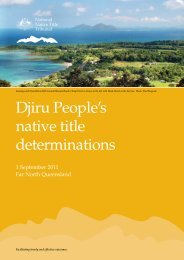Biodiveristy_State of Environment report - Mission Beach Cassowaries
Biodiveristy_State of Environment report - Mission Beach Cassowaries
Biodiveristy_State of Environment report - Mission Beach Cassowaries
- No tags were found...
You also want an ePaper? Increase the reach of your titles
YUMPU automatically turns print PDFs into web optimized ePapers that Google loves.
C4C4 are able champions <strong>of</strong> habitat preservation and havedemonstrated they are willing to take developers and theCouncil to court, in order to challenge decisions andpreserve the natural values <strong>of</strong> the <strong>Mission</strong> <strong>Beach</strong> area.It is important that C4 are willing to oppose developmentdecisions in this way, as all too <strong>of</strong>ten development goesahead with little regard for local community opinion. C4 aredetermined to preserve both the natural environment at<strong>Mission</strong> <strong>Beach</strong>, in order to maintain the area's character forresidents, to attract sustainable tourism, and to providehabitat for a diverse ecosystem <strong>of</strong> wildlife.C4 encouraged the developers <strong>of</strong> the Oasis Resort toachieve better environmental outcomes by incorporatingcassowary management advice from QPWS. These includedwidening <strong>of</strong> the original planned cassowary corridor,constraints on domestic cats and dogs belonging toresidents, and fencing <strong>of</strong> the developed area. Councilimproved the connection to the natural habitat corridor.Involvement in the drafting <strong>of</strong> the Shire Plan resulted ingood outcomes constraining development at Bingil Bay.Block sizes were kept larger, multi-residential blocks andhatchet shape blocks were no longer included in the plan.Bicton Close became a conservation area.C4 are still concerned about Council's support for thedevelopment <strong>of</strong> more multi-residential blocks along the<strong>Mission</strong> <strong>Beach</strong> foreshore and have courted the Department<strong>of</strong> <strong>Environment</strong> and Heritage (DEH) to support them wheredevelopment decisions are contrary to preservation <strong>of</strong> thearea. This will include lodging for registration <strong>of</strong> areasunder the EPBC Act, though this will formally be subject t<strong>of</strong>urther community consultation.The C4 Centre also plays other roles. The Centre itself is aninterpretive centre and gift shop, and includes a nursery fornative plants. C4 maintain the Arboretum adjacent to theCentre, which will be further extended northwards throughto the bridge. C4 would like to continue this park through tothe end <strong>of</strong> the beach. The Centre and Arboretum receivemost tourists passing through <strong>Mission</strong> <strong>Beach</strong>, and schoolgroups regularly visit for education and activities. Thenursery is extending its range, which consists primarily <strong>of</strong>cassowary food trees, but also stocks other native plantssuitable for gardens in the new residential areas.CouncilCouncil use critical cassowary habitat mapping to determineconservation covenants and bonus development rights,where cassowary habitat is preserved or restored.Revegetation progresses to re-establish linkages andcorridors. Council also maintains cassowary signage onCouncil roads. A road management strategy for wildlife isin progressRec: Council notify C4 <strong>of</strong> upcoming developments anddecisions to better involve them as representatives <strong>of</strong> the<strong>Mission</strong> <strong>Beach</strong> community, and as a resource to Councilfor community negotiation - CouncilRec: Council provide a number <strong>of</strong> temporary road signs forCouncil roads in cassowary areas, to be managed bycommunity volunteers to be sourced by QPWS - Council,QPWSLinken is the most recent chick to be rehabilitated at theCassowary Rehabilitation and Relocation Program. Linkenwas separated from his parent, a male bird who was havingtrouble raising his chick. QPWS received numerous calls<strong>report</strong>ing Linken's father, from residents who were concernedto see this bird limping continually. QPWS rangersinvestigated and found he was having a hard time keeping upwith young Linken, and finding enough food for him. It isthought that he has a form <strong>of</strong> osteoporosis due to his advancedyears. Neither <strong>of</strong> the birds was expected to survive.Separating them proved beneficial to both. Linken's father hassince recovered his health well, and Linken is growing at apace under QPWS's care. He will be released to the wild whenhe reaches suitable maturity as a sub-adult. Previous SoEupdates have featured photos <strong>of</strong> Lucky and Stretch, both <strong>of</strong>whom have been successfully released to the wild afterrehabilitation. Stretch's release was featured in AustralianGeographic (Oct - Dec 2004).Rec: Develop a sustainable tourism strategy for the Shire todefine development limits and maintain the naturalresource - Council, ConsultantRec: Further extend <strong>Mission</strong> <strong>Beach</strong> Park from C4 Centrethrough to the end <strong>of</strong> the beach, and integrate withwalking tracks. Coordinate with C4 to manage includingrevegetation and maintenance - Council, C4Rec: EPA Threatened Species Unit initiate populationmonitoring <strong>of</strong> cassowary population - EPA ThreatenedSpecies UnitRec: Research into cassowaries be encouraged byuniversity groups; including behaviour, the status <strong>of</strong>populations, inbreeding vulnerability, and diseases -QPWS, EPA Threatened Species UnitRec: Restrict urban development and place a population capon <strong>Mission</strong> <strong>Beach</strong> and other coastal areas wheresignificant cassowary populations exist - CouncilRec: Wildlife road management be prioritised in cassowaryareas - Council55



